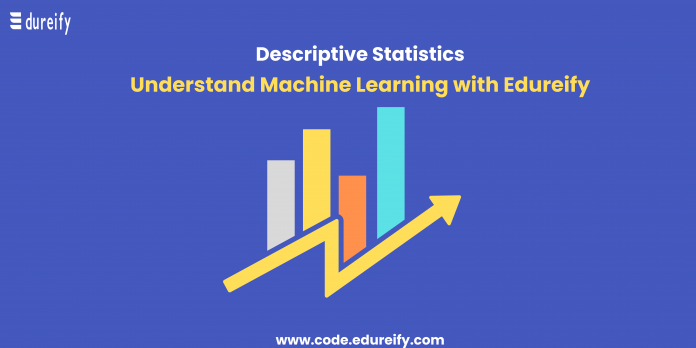Edureify, the best AI Learning App has come up with the best online coding courses for students to learn the important skills of web development and coding. Machine Learning is one of the most important digital concepts that has taken the world by a storm. In the trying times of Covid when life shifted to the online mode, it was Artificial Intelligence and Machine Learning, the two boons, that helped in running things online.
Edureify has previously talked about the different concepts related to Machine Learning, such as Azure Machine Learning, Machine Learning Algorithms, No-Code Machine Learning, and the A-Z Statistics of Machine Learning among others. In this article, Edureify will provide further information on the statistics of Machine Learning and focus particularly on Descriptive Statistics.
To learn more about Descriptive Statistics of Machine Learning, read on.
What is Descriptive Statistics?
Descriptive Statistics is referred to the in-depth analysis, summarization, and representation of data set collected from various surveys. Descriptive Statistics help determine whether the dataset sample can be normally distributed or not. It uses various methods to sample properties and data of the population and represents them in tables, charts, or frequency distributions.
Key Features of Descriptive Statistics
The following are some key points of the utilization of Descriptive Statistics-
- It provides a description and summary of the features of a dataset
- It mainly uses three main categories of measure- central tendency and measures of dispersion
- Helps to visualize a data to better understand and interpret it
Types of Descriptive Statistics
There are two major types of Descriptive Statistics-
- Central Tendency
- Measures of Dispersion/ Frequency Distribution
Central Tendency- The Central Tendency uses three main measures to describe the distribution of data using a single value, they are- Mean, Median, and Mode.
To learn more about the measures of Central Tendency, read Edureify’s article on the Measures of Central Tendency.
Measures of Dispersion- Measures of Dispersion is a type of Descriptive Statistics that provides an insight into how the data is spreading across a distance. The following are the various measures used to measure dispersion-
- Variance- This method measures how far each number in a set is from the mean and therefore, from all the other numbers in a set. The sigma squared symbol, σ2 depicts the variance.
- Standard Deviation- This method also lets the user know how far each number in a set is from the mean. Standard Deviation uses the square root of the variance. After calculation, if the data points are farther from the mean then the data set has a higher deviation. The higher the standard deviation, there is more spread in the data.
- Coefficient of Variation- The coefficient variation tracks the deviation of a dataset, i.e., gives an insight into the position of the data in terms of dispersion.
- Z-Score– Another similar measure, Z-Score shows the data spread around the mean. To be more particular, Z-Score tells the distance of a data point from the mean to the standard deviation.
- Range- The Range provides the difference between the maximum value and the minimum value.
Range= Maximum- Minimum
Example of Descriptive Statistics
The following are the examples of the different types of Descriptive Statistics-
- Example of a tabular representation of Descriptive Statistics-
| Gender | Number |
| Male | 70 |
| Female | 80 |
| Others | 35 |
- Example of Range-
An ordered set of data- 2, 5, 7, 10, 15
Range= 15-2= 13
Machine Learning requires one to use the best statistics to make the most use of the available data. So far, we discussed Descriptive Statistics. But primarily, there are two types of statistics, Descriptive and Inferential. The following is the difference between Descriptive and Inferential Statistics and depending upon the type of data representation a developer needs, one can decide on which form of statistics to use.
Difference between Descriptive and Inferential Statistics
| S.No. | Descriptive Statistics | Inferential Statistics |
| 1. | Descriptive Statistics provides descriptive information about data. | Inferential Statistics infers the data collected about a population. |
| 2. | It analyses, organizes and presents the data in the form of tables, charts, or graphs. | It enables one to compare, predict, and make a hypothesis about a collection of data. |
| 3. | It helps describe a situation. | It provides an insight into the chances of an event’s occurrence. |
| 4. | Explains data that is already known, one that is limited to a small size of the population. | It enables one to conclude about the population. |
| 5. | It presents data in the form of tables, charts, and graphs. | It uses probability. |
Edureify provides detailed coding courses on various Machine Learning tools and also helps students learn more about the various uses of Artificial Intelligence and Machine Learning. Students who take Edureify’s coding courses can learn about-
- Azure Machine Learning
- Machine Learning Algorithms
- No-Code Machine Learning
- The A-Z Statistics of Machine Learning, and other important programming languages and tools.
The certified coding courses of Edureify also provide the following benefits to the students-
- 200+ learning hours
- Learn from the industry experts
- Attend live lectures
- Get access to recorded lectures
- Participate in real-life projects
- Get career guidance and access to Edureify’s job portal
So wait no more. Join Edureify’s coding courses and learn more about the latest technological tools and developments easily.
Some FAQs on Descriptive Statistics-
1. What are the two main types of Statistics?
Descriptive and Inferential are the two main types of statistics.
2. What is Descriptive Statistics?
Descriptive Statistics is referred to the in-depth analysis, summarization, and representation of data set collected from various surveys. Descriptive Statistics help determine whether the dataset sample can be normally distributed or not.
3. What are the two main types of Descriptive Statistics?
The two main types of Descriptive Statistics are-
- Central Tendency
- Measures of Dispersion
4. How does Descriptive Statistics represent the data?
Descriptive Statistics represents data in the form of tables, charts, and graphs.
5. From where can I learn more about Descriptive Statistics for Machine Learning?
Edureify has the best online coding courses from which one can learn all about the statistics of Machine Learning and also about Descriptive Statistics of Machine Learning.
Master Your Coding Skills with BootSelf AI
If you're looking to enhance your coding abilities and upskill in artificial intelligence, look no further than the BootSelf AI app. This innovative platform provides AI-based coding lessons that are tailored to your individual learning pace.
Available on both iOS and Android, you can download the BootSelf AI app and start mastering coding skills today:












